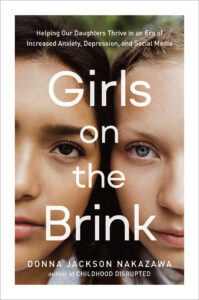Girls on the Brink by Donna Jackson Nakazawa (Book Excerpt)
 Excerpted from GIRLS ON THE BRINK by Donna Jackson Nakazawa. Copyright © 2022 by Donna Jackson Nakazawa. Used by permission of Harmony Books, an imprint of Random House, a division of Penguin Random House LLC, New York. All rights reserved. No part of this excerpt may be reproduced or reprinted without permission in writing from the publisher.
Excerpted from GIRLS ON THE BRINK by Donna Jackson Nakazawa. Copyright © 2022 by Donna Jackson Nakazawa. Used by permission of Harmony Books, an imprint of Random House, a division of Penguin Random House LLC, New York. All rights reserved. No part of this excerpt may be reproduced or reprinted without permission in writing from the publisher.
A good litmus test for the health of any society is how well it treats its girls and how well its girls are faring. When we look at the mental health of American girls today, one thing becomes clear: We as a society are failing pretty miserably. Depression has long been more prevalent in girls than in boys, but rates of depression in girls have now reached epidemic proportions. One out of four adolescent girls report suffering from symptoms of major depression compared with fewer than one in ten boys. Girls and young women are twice as likely as boys and young men to suffer from anxiety. In 2021, the Centers for Disease Control and Prevention reported that suicide attempts had recently increased 51 percent among girls compared with 4 percent among boys. These statistics cannot be explained by higher rates of awareness or diagnosis. They are real, and they are scary to every parent of every daughter and to anyone who cares about young women.
Even as rates of depression and anxiety in girls rise, the reasons behind this downturn in adolescent female health have been difficult to comprehend. Why does this disparity between girls’ and boys’ mental health emerge as girls enter puberty? And why is this trend worsening now? In the pages to come, I follow the discoveries of leading researchers who, in the face of today’s crisis among girls, have pivoted to answering these two questions. Not only do their findings tell us that we are raising girls in an era whose problems are different from those of previous generations, but they also offer us a new scientific understanding of how mounting adversities affect girls’ bodies and brains in surprising and unique ways. In the face of today’s ongoing toxic stressors, these negative effects can begin to manifest at a biological level in distinctly different ways as boys and girls enter puberty and come of age. This, coupled with the stress that accompanies simply growing up female in our society, is a more important driver of today’s depression and anxiety epidemic among girls than anyone previously realized.
When I first began to report on these scientific findings, I wondered if it was wise to try to view what lay behind today’s teen girl mental health crisis through a biological lens. Even as it became clear that something was happening to girls due to the environment in which they lived and that it affected them during puberty in ways distinct from boys, the question of whether sex differences played a role was not a room I was eager to enter. I feared even opening the door to the discussion, lest it be misused or misinterpreted in ways that harmed girls— wrongly implying that female biology was somehow weak, or that girls themselves were somehow to blame.
Nothing could be further from the truth. Let me say it clearly: The female body and brain are more susceptible to being adversely affected by chronic stress only when the source of that stress remains unaddressed and unmitigated. Indeed, in a healthy environment, one that fosters girls’ well-being, girls can possess distinct advantages in navigating adversity. Such an environment would include a healthy, strong relationship with parents and other adults; the experience of a deep psychological sense of safety in the world; and feeling seen and valued in society.
Adolescence is a time unlike any other, full of unimaginable promise— a golden period marked by learning and possibility and growth. As hormones rush in and begin to create visible physical changes, the brains of teens become especially ripe, agile, and flexible, open to new opportunities and experiences and to learning new approaches to self-awareness, coping, and connection that can prepare teens to navigate even highly complex challenges. And yet adolescence is also a precipice. Each young person stands at its brink, poised either to falter or to stride forward and thrive as they cross into young adulthood. So much depends on the emotional, social, and environmental terrain in which they come of age.
This may be truer for girls. The aspects of the female stress-threat response that make the female body susceptible to the biophysical ill effects of adversity and toxic environments as a girl comes into puberty are also what make the female adolescent brain remarkably flexible and responsive to positive shifts in a girl’s lived experience. But a supportive environment that provides strong scaffolding for a girl’s healthy development is not created merely through the absence of trial and adversity or by buffering children and teens from every form of toxic stress (even if such a thing were wise, or possible). A neuroprotective environment is one in which the conditions that foster a sense of being safely seen, deeply connected, and valued have been set in place by parents and other family members, mentors, and community. Each of these neuroprotective spheres of influence lies nestled inside the next, larger sphere, as with a series of Matryoshka dolls, each painted wooden doll held inside the next. If we are to grow strong girls, each neuroprotective sphere must pass the litmus test of whether girls feel secure and connected within it. Ultimately, this is what ensures that each girl, represented by the smallest figure at the center, feels safe within herself.
There are myriad ways we can harness the tremendous power of this science to promote new layers of resilience in girls. If we can identify the toxic chronic stressors a girl faces, reduce what stress we can, and provide adequate support in the face of adversity, we can create a different coming-of-age environment for girls, one that will yield a very different outcome. Indeed, we now understand the core factors that, when bundled together, are neurobiologically protective both in preventing mental health concerns in girls and in helping those girls who are already struggling.
Just as today’s change in girls’ health is not due to any single variation in their environment, protecting girls against negative shifts in the female brain and immune health likewise has many moving parts. The right interactions and interventions that help girls feel safe can promote a cascade of powerful changes at the biophysical level—acting as a cellular antidote to our culturally complicated, toxic era and setting the stage for new possibilities for flourishing. Over time, bundling together small micro changes can alter a girl’s life and emotional trajectory.

(photo credit: Marshall Clarke)
Donna Jackson Nakazawa is the author of four books that explore the intersection of neuroscience, immunology, and emotion, including The Angel and the Assassin, named one of the best books of 2020 by Wired magazine, and Childhood Disrupted, which was a finalist for the Books for a Better Life Award. Her latest book is GIRLS ON THE BRINK: Helping Our Daughters Thrive in an Era of Increased Anxiety, Depression, and Social Media. Her work has appeared in Wired, Stat, The Boston Globe, The Washington Post, Health Affairs, Parenting, AARP Magazine, and Glamour, and has been featured on the cover of Parade and in Time; she has appeared on Today, NPR, NBC News, and ABC News.
Tags: anxiety, depression, girls on the brink, Mom, parenting, raising daughters, support, teens















